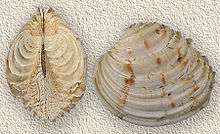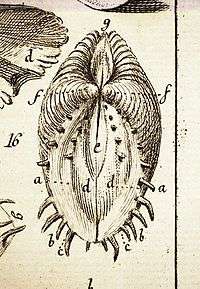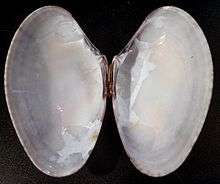Venus (bivalve)
Venus is a genus of small to large saltwater clams in the family Veneridae, which is sometimes known as the Venus clams and their relatives. These are marine bivalve molluscs.
| Venus clam | |
|---|---|
 | |
| Venus affinis | |
| Scientific classification | |
| Kingdom: | Animalia |
| Phylum: | Mollusca |
| Class: | Bivalvia |
| Subclass: | Heterodonta |
| Order: | Venerida |
| Family: | Veneridae |
| Genus: | Venus Linnaeus, 1758 |
| Species | |
|
See text. | |
Etymology
The genus Venus is named after the Greek goddess of love,Aphrodite. Venus for Romans
Taxonomy
However, some bivalves are still called Venus clams because they used to be in the genus Venus, though they are now placed in other genera: these include the species within the genus Mercenaria, and Pitar dione, the Venus shell described in sexual terms by Linnaeus.[1][2]
Fossil records
The genus is known from the Cretaceous to the recent periods (age range: from 136.4 Mya to now). Fossils shells have been found all over the world. About 20 extinct species are known.[3]
The family Veneridae
The family Veneridae contains over 400 known species, many of which are attractive and popular with shell-collectors.
The shells of venerids vary in shape, and include shells that are circular, triangular, and rectangular. Characteristically, Venus clams possess a porcelain-like inner shell layer, a complex tooth structure in the hinge, well-developed escutchion and lunule, and a well-developed pallial sinus.
Veneridae colonize the sandy ocean bottom, and their populations are often dense and large. The Veneroida order typically has a folded gill structure which is well developed for filtering out small food particles.
Common name

The common names of clams in this genus often include the name Venus. A few species that still have "Venus" as part of their common name, but which are no longer in the genus Venus are:
- Sunray Venus, Macrocallista nimbosa (Lightfoot)
- Cross-barred Venus, Chione cancellata (Linnaeus)
- Lady-in-waiting Venus, Chione intapurpurea (Conrad)
- Imperial Venus, Lirophora latilirata (Conrad)
- Grey pygmy Venus, Chione grus (Holmes)
- Striped Venus clam, Chamelea gallina (Linnaeus, 1758)
- Elegant Venus clam, Pitar dione (Linnaeus, 1758)
Species

The genus Venus contains these extant species:[4]
- Venus albina G. B. Sowerby II, 1853
- Venus casina Linnaeus, 1758
- Venus cassinaeformis (Yokoyama, 1926)
- Venus chevreuxi Dautzenberg, 1891
- Venus crebrisulca Lamarck, 1818
- Venus declivis G. B. Sowerby II, 1853
- Venus lyra Hanley, 1845
- Venus nux Gmelin, 1791
- Venus rosalina Rang, 1802
- Venus subrosalina Tomlin, 1923
- Venus thomassini Fischer-Piette & Vukadinovic, 1977
- Venus verdensis Dautzenberg & H. Fischer, 1906
- Venus verrucosa Linnaeus, 1758
References
- Linnaeus (1758). Systema Naturae (10th ed.). pp. 684–685.
- Linnaeus (1767). Systema Naturae (12th ed.). pp. 1128–1129.
- Fossilworks
- Philippe Bouchet, Mark Huber & Serge Gofas (2012). "Venus Linnaeus, 1758". WoRMS. World Register of Marine Species. Retrieved February 14, 2012.
External links
- Veneridae, Venus clams
- Veneridae, Venus clam
- Venus, Veneridae
- AMNH Veneridae holdings
- NC Sea Grant Seashells of NC Field Guide
- NC Seashells